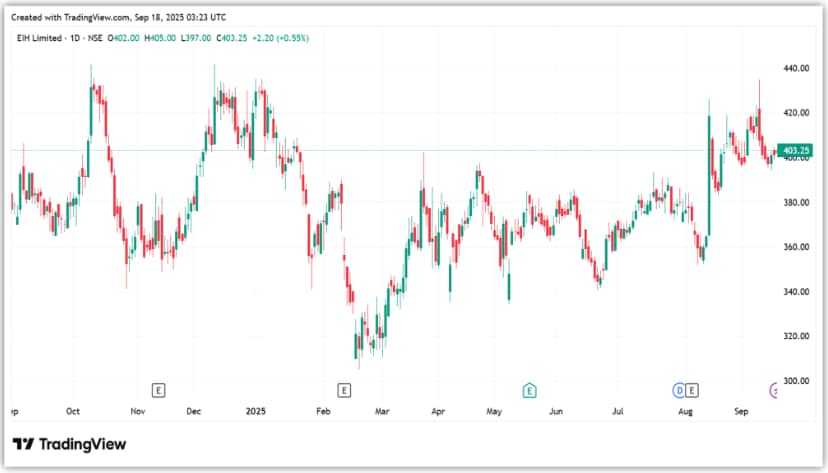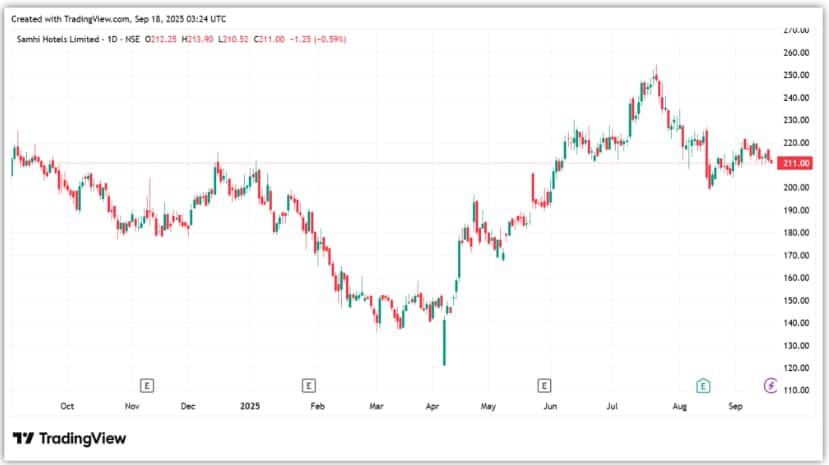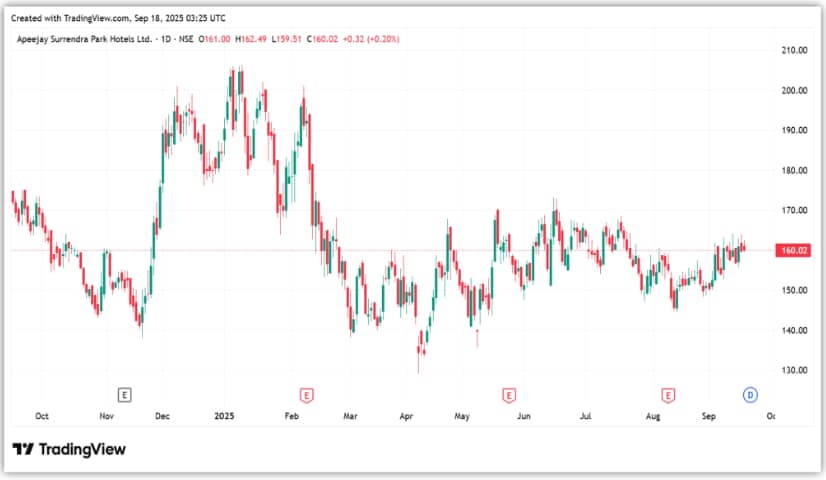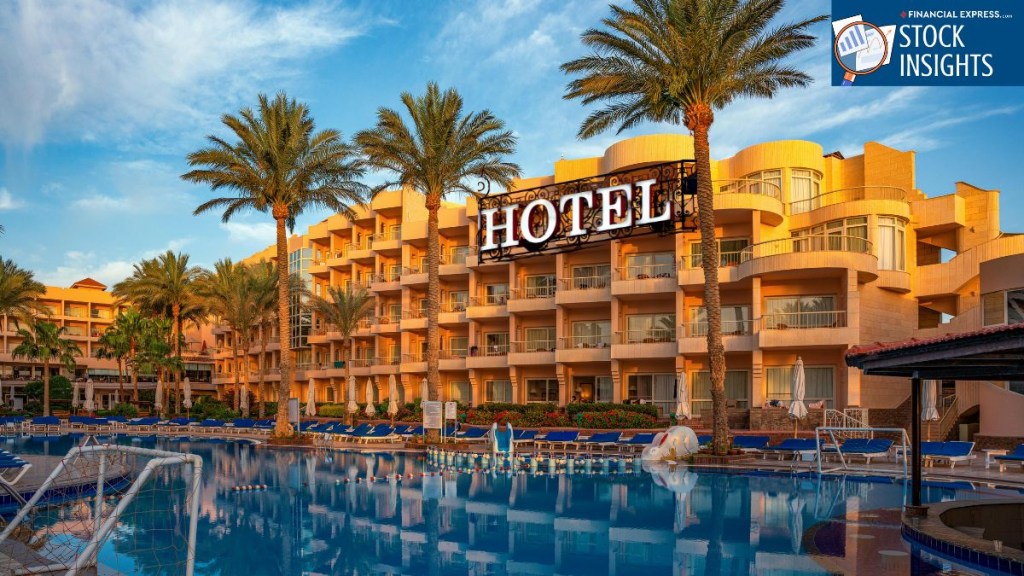Hotel sector stocks have delivered multi-bagger returns post-pandemic as travel revenue surged. This sharp rally, however, has also pushed valuations of leading hotel stocks to expensive levels. Even so, the sector remains well-positioned for expansion, supported by the ongoing growth of domestic tourism and corporate travel.
Key growth drivers are emerging in multiple areas, including spiritual tourism, live event tourism, cultural and heritage tourism, and infrastructure development. Alongside these, demand for high-end leisure travel is also on the rise, backed by an 11% increase in the Ultra High-Net Worth Individual base, as highlighted by EIH.
At the same time, inbound tourism is projected to grow by about 15% in FY26, aided by improved global connectivity.
While many stocks have already staged a record-breaking rally and turned costly, there are still a few trading at a discount to peers. This article highlights three such names that continue to trade below peers despite the sector’s strong momentum.
#1 East India Hotels (EIH)
EIH is a part of The Oberai Group. It is engaged in owning and managing premium luxury hotels and cruisers under ‘The Oberoi’ and ‘Trident’ brands. Beyond hotels, it also operates in flight catering, airport restaurants, project management, and corporate air charters.
As of 30 June 2025, the group manages 29 hotels, totaling 4,141 keys, of which 408 keys are under the Oberoi brand (International).
EIH delivers steady financial growth
From a financial standpoint, total revenue (including other income) rose 9% year-on-year to ₹6.1 billion in Q1FY26. This was driven by an 18% increase in the average room rate of domestic hotels (including managed) to ₹16,268. Occupancy stayed flat at 70%.
Revenue per available room (RevPAR) rose 15.7% to ₹11,352, with the company continuing to lead on this metric. The revenue growth was temporarily affected by geopolitical events, resulting in a short-term deviation.
EBITDA (earnings before interest, tax, depreciation, and amortization) rose 16% to ₹1.9 billion, with margin expanding by 420 bps to 37.3%. However, profit after tax (PAT) declined 62% to ₹369 million, due to an exceptional loss of ₹1.1 billion.
It also maintains an industry-leading return ratio, with a Return on Equity (RoE) of 17.9% and a Return on Capital Employed (RoCE) of 23%.
EIH expansion led by Vision 2030
Looking ahead, the group aims to expand to 54 hotels by 2030, with a focus on quality and cultural authenticity in prime locations. To this end, it has devised an expansion strategy that includes 25 properties (The Oberoi (15), Trident (7), Luxury Boats and Nile Cruiser (3)) with 2,033 keys.
The company is entirely focused on achieving its Vision 2030, aiming to double its room count. It will own eight of these, while the remaining ones will be managed by it. The company is net cash positive with liquidity of Rs 11.5 billion, which gives it the strength to pursue this expansion without straining its balance sheet.
EIH trades at a discount

From a valuation perspective, EIH is trading at an EV/EBITDA multiple of 19.8x, which is slightly below its 10-year median of 21x. However, what’s interesting is that it trades at a discount to its peers, including Indian Hotels (36x), ITC Hotels (36.6x), Chalet (26.2x), and Lemon Tree (24x).
#2 SAMHI Hotels
Samhi Hotel is India’s fastest-growing and third-largest hotel company in terms of the number of rooms. It has a robust portfolio of 31 high-end hotels with 4,806 keys, with hotels around 13 Indian cities.
Samhi’s business model focuses on acquiring and scaling hotel brands. Its portfolio comprises 87% of hotels that were revived after acquisition, and 13% are greenfield hotels. The hotels are well-diversified across upper-scale, upper-mid-scale, and mid-scale categories.
It operates hotels in partnership with eleven recognised brands, including Hyatt, Marriott, Holiday Inn, and Renaissance. This association provides access to their marketing strategies, operational expertise, and loyalty programs.
Samhi delivers strong financial performance.
From a financial standpoint, total income rose 13% year-on-year to ₹2.8 billion in Q1FY26, driven by a 10% increase in RevPAR to ₹4,760. Business was temporarily affected by geopolitical events, resulting in a short-term deviation. EBITDA grew 18.6% to ₹1 billion, while PAT jumped almost fivefold to ₹192 million from 42 million in Q1FY25.
The company is continuously deleveraging its balance sheet, and net debt-to-EBITDA has now declined to 3.1x, down from 4.9x in the same period last year. Annual interest costs have now dropped to ₹1.4 billion, down from ₹1.9 billion in the same period.
Looking ahead, SAMHI anticipates overall revenue growth in the early double digits in the long term. The company also expects its EBITDA to increase by approximately ₹600 million, driven by operating leverage. It also aims to generate a free cash flow of Rs 3.6 billion in FY26, which will be utilized to enhance its balance sheet.
Samhi expansion supported by asset pipeline
The company also has a strong asset pipeline. In the short term, Sheraton (Hyderabad) is expected to add 54 new rooms, and Hyatt Regency (Pune) will add 22 rooms. Both these hotels are expected to start contributing to existing revenue from FY26.
Additionally, a 362-room Westin and Tribute dual-branded hotel is expected to contribute from FY26 onwards. Thereafter, a 170-room Marriott’s W hotel is scheduled to commence operations from the second half of FY27. Samhi has also formed a partnership with GIC to reduce debt and pursue growth opportunities.
Samhi trades at a discount to peers.
From a valuation perspective, Samhi is trading at an EV/EBITDA multiple of 15.5x, which is slightly below its 2-year median of 19.7x. It also trades at a discount to its peers, including Indian Hotels (36x), ITC Hotels (36.6x), Chalet (26.2x), and Lemon Tree (24x).

#3 Apeejay Surrendra Park Hotels
Apeejay Surrendra Park is India’s eighth-largest asset-owning hotel chain and a pioneer in the luxury boutique segment. It has a diversified portfolio of five hospitality brands, catering to guests across the luxury-to-economy spectrum.
Company scales hotels and F&B portfolio.
These include The Park Hotels and The Park Collection, which are in the luxury and upscale segments. Next come brands like Zone by the Park and Zone Connect by the Park in the upper midscale segment, and Stop by Zone in the economy segment.
It has 35 operational hotels, with 2,394 keys and 31 hotels under development, totalling 66 properties and 5,403 keys. The company operates through a balanced mix of ownership (1,101), asset-light managed models (999), and leasing (294). It plans to reach 73 hotels, totalling 5,750 keys by FY30.
The company also has a strong presence in the retail food and beverage (F&B) sector with its 100-year-old bakery and confectionery brand, Flurys. Flurys has expanded to 100 outlets across India and plans to reach 200 stores by FY27, and 300-400 by FY30. F&B contributed 42% to the company’s total revenue in Q1FY26.
Financial performance improves in Q1FY26.
Now, coming to its financials. Revenue rose 13% year-on-year to 1.5 billion in Q1FY26, driven by industry-leading 92% occupancy. Average room revenue increased 13% to ₹7,335, and RevPAR rose 12% to ₹ 6,751. EBITDA also increased by 12% to ₹480 million, while margins remained at 30%.
The company recovered from a loss of ₹20 million last year to a profit with a PAT of ₹130 million. It is almost net-debt-free, with net debt of only ₹10 million. Apart from profitability pressure, its RoE is only 6.7%, and RoCE is 12%, which explains why it trades at a low valuation.
Expansion through an inorganic route
Looking ahead, a memorandum of understanding (MoU) has been signed to acquire Malabar House in Fort Kochi (31 rooms). It also plans to complete one strategic acquisition in FY26: 80 rooms at Zillion Hotels and Resorts at Juhu (90% stake for ₹2 billion).
It has also signed an MoU to manage four properties in Goa, Manali, Shimla, and Dharamsala, which will broaden its geographic reach. These acquisitions aim to strengthen positions in both business and luxury segments.
Additionally, there are upcoming projects in Kochi, Mumbai, Pune, Visakhapatnam, Kolkata, and Jaipur. The company is expected to add 589 rooms in FY26, comprising 411 rooms under management contracts (asset-light), leased agreements (147), and 31 rooms under ownership.
This will increase the total number of hotels from 35 (2,394 keys) to 50 hotels (2,983 keys). These additions, combined with organic growth, are expected to drive sustained high double-digit growth in both revenues and EBITDA.
Valuations remain at a discount to peers
Valuation-wise, it is trading at an EV/EBITDA multiple of 15.2x. It’s just a one-year-old listing. That said, its valuation is at a discount to its peers, including Indian Hotels (36x), ITC Hotels (36.6x), Chalet (26.2x), and Lemon Tree (24x).
Apeejay Surrendra Park Share Price

Bottomline
All the hotel companies discussed above operate in the premium segment. Their positioning, however, differs. EIH stands out as a formidable player with legacy brands like Oberoi and Trident. It has strong financials, healthy return ratios, and a clear long-term growth vision.
Samhi has built its model around acquisitions and partnerships with global hotel chains. This strategy gives it scale and access to established loyalty networks. Apeejay Surrendra Park combines boutique hospitality with a growing retail F&B presence through Flurys. This gives it a diversified revenue base.
Despite their different approaches, they share a standard feature. All three trade at a discount to sector leaders such as Indian Hotels, ITC Hotels, Lemon Tree, and other hotels. Thus, improvements in the financials could fill some of the valuation.
Disclaimer:
Note: Throughout this article, we have relied on data from http://www.Screener.in and the company’s investor presentation. Only in cases where the data was not available have we used an alternate but widely used and accepted source of information.
The purpose of this article is only to share interesting charts, data points, and thought-provoking opinions. It is NOT a recommendation. If you wish to consider an investment, you are strongly advised to consult your advisor. This article is strictly for educational purposes only.
About the Author: Madhvendra has been deeply immersed in the equity markets for over seven years, combining his passion for investing with his expertise in financial writing. With a knack for simplifying complex concepts, he enjoys sharing his honest perspectives on startups, listed Indian companies, and macroeconomic trends.
A dedicated reader and storyteller, Madhvendra thrives on uncovering insights that inspire his audience to deepen their understanding of the financial world.
Disclosure: The writer and his dependents do not hold the stocks discussed in this article.
The website managers, its employee(s), and contributors/writers/authors of articles have or may have an outstanding buy or sell position or holding in the securities, options on securities or other related investments of issuers and/or companies discussed therein. The articles’ content and data interpretation are solely the personal views of the contributors/ writers/authors. Investors must make their own investment decisions based on their specific objectives, resources, and only after consulting such independent advisors as may be necessary.

